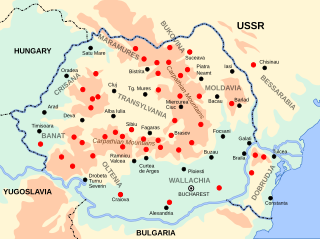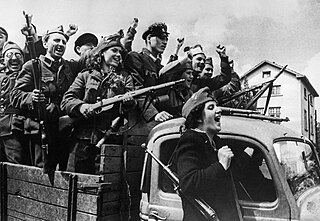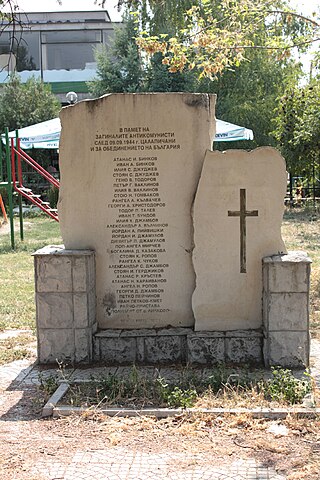A resistance movement is an organized group of people that tries to resist the government or an occupying power, causing disruption and unrest in civil order and stability. Such a movement may seek to achieve its goals through either the use of violent or nonviolent resistance, or the use of force, whether armed or unarmed. In many cases, as for example in the United States during the American Revolution, or in Norway in the Second World War, a resistance movement may employ both violent and non-violent methods, usually operating under different organizations and acting in different phases or geographical areas within a country.

The Ukrainian Insurgent Army was a Ukrainian nationalist paramilitary and partisan formation founded by the Organization of Ukrainian Nationalists on 14 October 1942. During World War II, it was engaged in guerrilla warfare against Nazi Germany, the Soviet Union, and both the Polish Underground State and Polish Communists. It conducted the massacres of Poles in Volhynia and Eastern Galicia.
Soviet partisans were members of resistance movements that fought a guerrilla war against Axis forces during World War II in the Soviet Union, the previously Soviet-occupied territories of interwar Poland in 1941–45 and eastern Finland. The activity emerged after Nazi Germany's Operation Barbarossa was launched from mid-1941 on. It was coordinated and controlled by the Soviet government and modeled on that of the Red Army.
During World War II, resistance movements operated in German-occupied Europe by a variety of means, ranging from non-cooperation to propaganda, hiding crashed pilots and even to outright warfare and the recapturing of towns. In many countries, resistance movements were sometimes also referred to as The Underground.

A partisan is a member of a domestic irregular military force formed to oppose control of an area by a foreign power or by an army of occupation by some kind of insurgent activity.

During World War II, Lithuania was occupied twice by the Soviet Union and once by Nazi Germany (1941–1944). Resistance took many forms.

The "cursed soldiers" or "indomitable soldiers" were a heterogeneous array of anti-Soviet-imperialist and anti-communist Polish resistance movements formed in the later stages of World War II and in its aftermath by members of the Polish Underground State. The above terms, introduced in the early 1990s, reflect the stance of many of the diehard soldiers.

The Romanian anti-communist resistance movement was active from the late 1940s to the mid-1950s, with isolated individual fighters remaining at large until the early 1960s. Armed resistance was the first and most structured form of resistance against the Romanian People's Republic, which in turn regarded the fighters as "bandits". It was not until the overthrow of Nicolae Ceaușescu in late 1989 that details about what was called "anti-communist armed resistance" were made public. It was only then that the public learned about the several small armed groups, which sometimes termed themselves "hajduks", that had taken refuge in the Carpathian Mountains, where some hid for ten years from authorities. The last fighter was eliminated in the mountains of Banat in 1962. The Romanian resistance was one of the longest lasting armed movements in the former Eastern Bloc.
Anti-communist resistance in Poland can be divided into two types: the armed partisan struggle, mostly led by former Armia Krajowa and Narodowe Siły Zbrojne soldiers, which ended in the late 1950s, and the non-violent, civil resistance struggle that culminated in the creation and victory of the Solidarity trade union.

The Bulgarian Resistance was part of the anti-Axis resistance during World War II. It consisted of armed and unarmed actions of resistance groups against the Wehrmacht forces in Bulgaria and the Tsardom of Bulgaria authorities. It was mainly communist and pro-Soviet Union. Participants in the armed resistance were called partizanin and yatak.

The anti-communist resistance in Poland, also referred to as the Polish anti-communist insurrection fought between 1944 and 1953, was an anti communist and anti-Soviet armed struggle by the Polish Underground against the Soviet domination of Poland by the Soviet-installed People's Republic of Poland, since the end of World War II in Europe. The guerrilla warfare conducted by the resistance movement formed during the war, included an array of military attacks launched against communist prisons, state security offices, detention facilities for political prisoners, and prison camps set up across the country by the Stalinist authorities.

Anti-Soviet partisans may refer to various resistance movements that opposed the Soviet Union and its satellite states at various periods during the 20th century.
Anti-communist resistance may refer to:
The Soviet partisans in Latvia were Soviet partisans who were deployed to Latvia and attempted to wage guerrilla warfare against the German armed forces during the German occupation of Latvia. Partisan activity was singularly unsuccessful in Latvia due to the general resistance of the population to the Soviet regime that the partisans represented.

Latvian national partisans were Latvian pro-independence partisans who waged guerrilla warfare against Soviet rule during and after the Second World War.

Lithuanian partisans were partisans who waged guerrilla warfare in Lithuania against the Soviet Union in 1944–1953. Similar anti-Soviet resistance groups, also known as Forest Brothers and cursed soldiers, fought against Soviet rule in Estonia, Latvia and Poland. An estimated total of 30,000 Lithuanian partisans and their supporters were killed. The Lithuanian partisan war lasted almost for a decade, thus becoming one of the longest partisan wars in Europe.
The history of guerrilla warfare stretches back to ancient history. While guerrilla tactics can be viewed as a natural continuation of prehistoric warfare, the Chinese general and strategist Sun Tzu, in his The Art of War, was the earliest to propose the use of guerrilla warfare. This directly inspired the development of modern guerrilla warfare. Communist leaders like Mao Zedong and North Vietnamese Ho Chi Minh both implemented guerrilla warfare in the style of Sun Tzu, which served as a model for similar strategies elsewhere, such as the Cuban "foco" theory and the anti-Soviet Mujahadeen in Afghanistan. While the tactics of modern guerrilla warfare originate in the 20th century, irregular warfare, using elements later characteristic of modern guerrilla warfare, has existed throughout the battles of many ancient civilizations.

The Goryani movement or Goryanstvo was an active guerrilla resistance against the Soviet-aligned People's Republic of Bulgaria. It began immediately after the Ninth of September coup d'état in 1944 which opened the way to communist rule in Bulgaria, and ended in 1956. The movement covered the entire country, including urban areas and is known to have been the first organised anti-Soviet armed resistance in eastern Europe as well as the longest lasting.

The guerrilla war in the Baltic states was an insurgency waged by Baltic partisans against the Soviet Union from 1944 to 1956. Known alternatively as the "Forest Brothers", the "Brothers of the Wood" and the "Forest Friars", these partisans fought against invading Soviet forces during their occupation of the Baltic states during and after World War II. Similar insurgent groups resisted Soviet occupations in Bulgaria, Poland, Romania and Ukraine.












